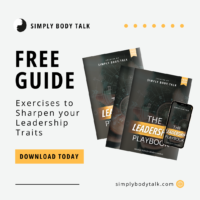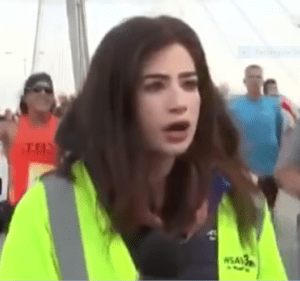Remember in one of the previous articles we spoke of Freeze which is a part of the famous three Fs- Freeze, Flight, and Fight. It is our body’s automatic response to save ourselves from any threat or discomfort around us. If you didn’t read that article, here it is.
THE VIRAL VIDEO
Today we discuss the recent news of Alex Bozarjian the news reporter of Savannah station WSAV-TV who while live reporting on the race in Savannah was shocked as a runner named Tommy Callaway a local leader of both the Cub Scouts and a church youth group moved behind her and slapped her butt. The video has gone viral since.
Let’s see how Freeze played a role in this news.
In this particular instance below, before the incident, we find Alex being very happy while reporting. She is very excited as her volume is high, she is raising her eyebrow which is a nonverbal way of showing excitement.
 Alex raised her eyebrows and speaking with excitement
Alex raised her eyebrows and speaking with excitement
She is also using hand gestures very naturally to explain what she is speaking about before the incident.
Alex using hand gestures naturally while speaking
WHEN THE INCIDENT OCCURS
In the same instance that Alex is slapped, she freezes on the spot. Freeze reaction comes to us when something highly unacceptable or uncomfortable happens. This reaction generally helps us understand what just happened, and then we react to this incident.
Here is Alex froze to realize what happened
In Alex’s case, she shows shock through her mouth which is slightly open, her eyebrows are lowered, and her focus is not anymore on the camera but on Tommy who just goes by.
Alex reacting to the incident with shock
WHAT IF YOU HAD NOT NOTICED THE FREEZE REACTION?
After her freeze reaction, we see a pause which is followed by Alex repeating the words she just spoke but the previous enthusiasm is missing. We find an immediate change in her voice and her eyebrows been lowered. Slowly she shifts her focus back to the camera.
Alex with different body language, at least temporarily
SO WHAT DOES THIS MEAN?
If we want to understand a person from their body language, we first establish their normal way of behaving. This is known as baseline behavior. In Alex’s example, we see how she is someone who is more prone to using hand gestures, raising her eyebrows, she is passionate by leaning in while she is speaking. All these different ways of using her body cue or cluster are her baseline.
Once the baseline behavior is understood, we look for changes in their behavior or actions. In Alex’s case, we see no hand movements, no eyebrow raise, and changes in tone. This helps us understand that she is visibly tensed.
HOW CAN WE USE THIS IN DAILY LIFE?
Say you were sitting across from a fellow negotiator or a potential job candidate, and asking them some difficult questions. A question that throws them off their guard. They would normally show this through their freeze reaction. It happens in a split second and might be missed by those who are not master observers. But if you had observed how the baseline behavior of your partner was before you asked the difficult question, then this change in their reaction would help you understand that something changed.
What was the something which changed, is going to be up to you to decipher, since you would be the best judge of what was the conversation all about. But body language would play a crucial role in leading you to see that something has visibly disturbed your partner. And that is why, it is important to see beyond what is superficially visible!
Read our previous article on deciphering baseline behavior.
During this lockdown period, get exciting offers on our webinars to know more visit here.
Images courtesy: CBS This Morning























